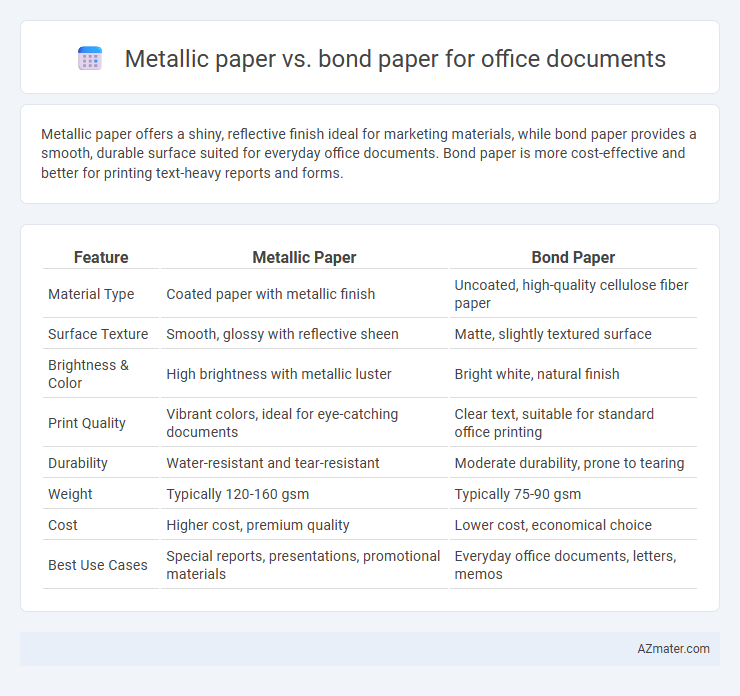Metallic paper offers a shiny, reflective finish ideal for marketing materials, while bond paper provides a smooth, durable surface suited for everyday office documents. Bond paper is more cost-effective and better for printing text-heavy reports and forms.
Table of Comparison
| Feature | Metallic Paper | Bond Paper |
|---|---|---|
| Material Type | Coated paper with metallic finish | Uncoated, high-quality cellulose fiber paper |
| Surface Texture | Smooth, glossy with reflective sheen | Matte, slightly textured surface |
| Brightness & Color | High brightness with metallic luster | Bright white, natural finish |
| Print Quality | Vibrant colors, ideal for eye-catching documents | Clear text, suitable for standard office printing |
| Durability | Water-resistant and tear-resistant | Moderate durability, prone to tearing |
| Weight | Typically 120-160 gsm | Typically 75-90 gsm |
| Cost | Higher cost, premium quality | Lower cost, economical choice |
| Best Use Cases | Special reports, presentations, promotional materials | Everyday office documents, letters, memos |
Introduction to Metallic Paper and Bond Paper
Metallic paper features a shiny, reflective surface that enhances visual appeal, making it ideal for presentations, marketing materials, and special documents requiring eye-catching design. Bond paper, commonly used in office settings, is valued for its durability, smooth texture, and compatibility with most printers, suitable for everyday printing and document handling. Choosing between metallic and bond paper depends on the balance between aesthetic impact and practical office use.
Key Differences Between Metallic Paper and Bond Paper
Metallic paper features a shiny, reflective surface ideal for high-impact presentations and marketing materials, while bond paper is a durable, matte-finished option commonly used for everyday office documents and printing. Bond paper offers higher opacity and smoother texture, making it better suited for readability and standard printing tasks, whereas metallic paper's unique finish can cause glare and is less compatible with ordinary printers. The cost of metallic paper is generally higher due to its specialized coating, whereas bond paper is more economical and widely available.
Physical Characteristics: Texture, Thickness, and Finish
Metallic paper features a smooth, reflective surface with a glossy finish that enhances visual appeal, while bond paper has a matte or slightly textured finish that is ideal for readability and professional documents. Thickness varies, with metallic paper generally thicker and more rigid, often ranging from 180 to 250 gsm, compared to bond paper's lighter 75 to 90 gsm weight that allows easy handling and printing. The texture of metallic paper is sleek and polished, contrasting bond paper's fibrous, slightly rough feel that promotes ink absorption and clarity in text-based materials.
Print Quality and Color Reproduction
Metallic paper offers superior print quality with vivid, high-gloss finishes that enhance color depth and sharpness, making it ideal for presentation documents requiring vibrant visuals. Bond paper, while more economical and widely used for everyday office documents, provides consistent, clear print results with a matte texture that minimizes glare but offers less color saturation. The choice between metallic and bond paper significantly impacts color reproduction and overall document appearance, especially for graphics-heavy prints or formal reports.
Professional Appearance and Document Impact
Metallic paper offers a striking professional appearance with its reflective, high-gloss finish that enhances visual appeal and draws attention to office documents. Bond paper provides a classic, smooth texture that ensures readability and a formal look suitable for official correspondence and reports. Choosing metallic paper increases document impact in presentations or marketing materials, while bond paper maintains a traditional and authoritative tone for business communications.
Cost Comparison: Metallic Paper vs Bond Paper
Metallic paper typically costs 50-100% more than standard bond paper due to its specialty coatings and unique finish, making it less economical for large-volume office printing. Bond paper, priced around $5-$10 per ream of 500 sheets, remains the most cost-effective choice for everyday documents and office correspondence. While metallic paper enhances visual appeal, its higher cost limits use to marketing materials rather than routine office documentation.
Durability and Longevity for Office Documents
Metallic paper features a glossy, reflective surface that enhances visual appeal but is prone to scratches and bending, impacting durability over time. Bond paper, known for its sturdiness and resistance to wear, excels in longevity, making it ideal for frequent handling and archival office documents. For preserving document integrity and ensuring long-term use, bond paper is the preferred choice due to its robustness and ability to withstand everyday office conditions.
Suitability for Printers and Office Equipment
Metallic paper often requires printers with special capabilities, such as laser printers designed to handle heavy or coated media, while bond paper is compatible with most standard inkjet and laser printers used in office settings. Bond paper's versatility and smooth surface ensure consistent ink absorption and reduced jamming risks, making it ideal for everyday office documents like reports and memos. Metallic paper may cause wear on printer components and is better suited for specialized print jobs rather than routine office printing tasks.
Environmental Impact and Recyclability
Metallic paper often contains synthetic coatings and metallic foils, which significantly reduce its recyclability and increase environmental impact due to non-biodegradable components and higher energy consumption during production. Bond paper is typically made from natural fibers, making it easier to recycle and more environmentally friendly, with a lower carbon footprint and biodegradable properties. Choosing bond paper over metallic paper for office documents supports sustainable practices and minimizes waste in recycling streams.
Best Use Cases: Choosing the Right Paper for Your Office Documents
Metallic paper is ideal for creating eye-catching presentation covers, brochures, and promotional materials due to its reflective surface and vibrant finish, which enhances visual impact. Bond paper is the preferred choice for everyday office documents such as memos, letters, and reports because of its durability, smooth texture, and compatibility with most printers and copiers. Selecting metallic paper elevates marketing collateral quality, while bond paper ensures professional and cost-effective printing for routine office tasks.

Infographic: Metallic paper vs Bond paper for Office document
 azmater.com
azmater.com